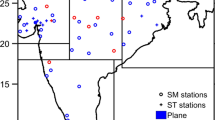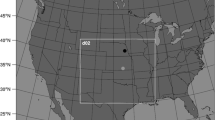Abstract
Land Data Assimilation Systems have been developed to generate the surface initial conditions such as soil moisture and temperature for better prediction of weather and climate. We have constructed Korea Land Data Assimilation System (KLDAS) based on an uncoupled land surface modeling framework that integrates high-resolution in-situ observation, satellite data, land surface information from the WRF Preprocessing System (WPS) and the MODIS land products over the East Asia. To present better surface conditions, the KLDAS is driven by atmospheric forcing data from the in-situ rainfall gauges and satellite. In this study, we 1) briefly introduce the KLDAS, 2) evaluate the meteorological states near the surface and the surface fluxes reproduced by the KLDAS against the in-situ observation, and then 3) examine the performance of the mesoscale model initialized by the KLDAS. We have generated a 5-year, 10 km, hourly atmospheric forcing dataset for use in KLDAS operating across East Asia. The KLDAS has effectively reproduced the observed patterns of soil moisture, soil temperature, and surface fluxes. Further scrutiny reveals that the numerical simulations incorporating the KLDAS outputs show better agreement in both the simulated near-surface conditions and rainfall distribution over the Korean Peninsula, compared to those without the KLDAS.
Similar content being viewed by others
References
Abramowitz, G., R. Leuning, M. Clark, and A. Pitman, 2008: Evaluating the performance of land surface models. J. Climate, 21, 5468–5481. Doi:10.1175/2008JCLI2378.1.
Avissar, R., and Pielke, R. A., 1989: A parameterization of heterogeneous land surface for atmospheric numerical models and its impact on regional meteorology. Mon. Wea. Rev., 117, 2113–2136.
Baldocchi, D. D., and Coauthors, 2001: FluxNet: A new tool to study the temporal and spatial variability of ecosystem-scale carbon dioxide, water vapor, and energy flux densities. Bull. Amer. Meteor. Soc., 82, 2415–2424.
Case, J. L., W. L. Crosson, S. V. Kumar, W. M. Lapenta, and C. D. Peters-Lidard, 2008: Impacts of high-resolution land surface initialization on regional sensible weather forecasts from the WRF model, J. Hydrometeor., 9, 1249–1266.
Chen, F., and J. Dudhia, 2001: Coupling an advanced land surfacehydrology model with the Penn State-NCAR MM5 modeling system. Part I: Model implementation and sensitivity. Mon. Wea. Rev., 129, 569–585.
____, K. Mitchell, J. Schaake, Y. Xue, H.-L. Pan, V. Koren, Q. Y. Duan, M. Ek, and A. Betts, 1996: Modeling of land-surface evaporation by four schemes and comparison with FIFE observation. J. Geophys. Res., 101(D3), 7251–7268, doi:10.1029/95JD02165.
____, and Coauthors, 2007: Description and evaluation of the characteristics of the NCAR high-resolution land data assimilation system. J Appi. Meteor. Climatol., 46, 649–713.
Cosgrove, B. A., and Coauthors, 2003a: Real-time and retrospective forcing in the North American Land Data Assimilation System (NLDAS) project. J. Geophys. Res., 108(D22), 8842, doi:10.1029/2002JD003118.
____, and Coauthors, 2003b: Land surface model spin-up behavior in the North American Land Data Assimilation System (NLDAS). J. Geophys. Res., 108(D22), 8845, doi:10.1029/2002JD003316.
Dai, Y., and Coauthors, 2003: The Common Land Model. Bull. Amer. Meteor. Soc., 84, 1013–1023.
de Goncalves, L. G. G., W. J. Shuttleworth, E. J. Burke, P. Houser, D. L. Toll, M. Rodell, and K. Arsenault, 2006: Toward a South America Land Data Assimilation System: Aspects of land surface model spin-up using the Simplified Simple Biosphere. J. Geophys. Res., 111, D17110, doi:10.1029/2005JD006297.
Dudhia, J., 1989: Numerical study of convection observed during the winter monsoon Experiment using a mesoscale two-dimensional model. J. Atmos. Sci., 46, 3077–3107.
Ek, M. B., K.E. Mitchell, and Y. Lin, E. Rogers, P. Grunmann, V. Koren, G. Ganyo, and J. D. Tarpley, 2003: Implementation of Noah land surface model advances in the National Centers for Environmental Prediction operational mesoscale Eta model. J. Geophys., Res., 108(D22), 8851, doi:10.1029/2002JD003296.
Gutman, G., and A. Ignatov, 1998: The derivation of green vegetation fraction from NOAA/AVHRR data for use in numerical weather prediction models. Int. J. Remote Sens., 19(8), 1533–1543, doi:10.1080/014311698215333.
Holt, T. R., D. Niyogi, F. Chen, K. Manning, M. A. LeMone, and A. Qureshi, 2006: Effect of land-atmosphere interactions on the IHOP 24–25 May 2002 convection case, Mon. Wea. Rev., 134, 113–133.
Hong, J., and J. Kim, 2010: Numerical study of surface energy partitioning on the Tibetan Plateau: Comparative analysis of two biosphere models. Biogeosci., 7, 557–568.
Hong, S., V. Lakshmi, E. E. Small, F. Chen, M. Tewari, and K. W. Manning, 2009: Effects of vegetation and soil moisture on the simulated surface processes from the coupled WRF/Noah model. J, Geophys. Res., 114, D18118, doi:10.1029/2008JD011249.
Hong, S.-Y., and J.-O. J. Lim, 2006: The WRF single-moment 6-class microphysics scheme (WSM6). J. Korean Meteor. Soc. 42, 129–151.
____, Y. Noh, and J. Dudhia, 2006: A new vertical diffusion package with an explicit treatment of entrainment processes. Mon. Wea. Rev., 134, 2318–2341.
Jedlovec, G. J., and K. Law, 2003: GORE cloud detection at the Global Hydrology and Climate Center. Preprints, 12th Conf. on Satellite Meteorology and Oceanography, Long Beach, CA, Amer. Meteor. Soc. CD-ROM, P1.21.
Kim, J., and Coauthors, 2006: HydroKorea and CarboKorea: Cross-scale studies of ecohydrology and biogeochemistry in a heterogeneous and complex forest catchment of Korea. Ecological Research, 21, 881–889.
Kim, J.-E., and S.-Y. Hong, 2007: Impact of soil moisture anomalies on summer rainfall over East Asia: A regional climate model study. J. Climate, 20, 5732–5743.
Koster, R. D., and M. J. Suarez, 2003: Impact of land surface initialization on seasonal precipitation and temperature prediction. J. Hydrometeor., 4, 408–423.
____, and Coauthors, 2004: Realistic initialization of land surface states: Impacts on subseasonal forecast skill. J. Hydrometeor., 5, 1049–1063.
Kumar, S. V., and Coauthors, 2006: Land Information System: An interoperable framework for high resolution land surface modeling. Environ. Modell. Software, 21, 1402–1415.
Li, Z, and A. Trishchenko, 1999: A study toward an improved understanding of the relationship between visible and shortwave albedo measurements. J. Atmos. Oceanic Technol., 16, 347–360.
____, H. G. Leighton, K. Masuda, and T. Takashima, 1993: Estimation of SW flux absorbed at the surface from TOA reflected flux. J. Climate, 6, 317–330.
Miller, J., M. Barlage, X. Zeng, H. Wei, K. Mitchell, and D. Tarpley, 2006: Sensitivity of the NCEP/Noah land surface model to the MODIS green vegetation fraction data set. Geophys. Res. Lett., 33, L13404, doi: 10.1029/2006GL026636.
Mitchell, K. E., and Coauthors, 2004: The multi-institution North American Land Data Assimilation System (NLDAS): Utilizing multiple GCIP products and partners in a continental distributed hydrological modeling system. J. Geophys. Res., 109, D07S90, doi:10.1029/2003JD003823.
Mlawer, E. J., S. J. Taubman, P. D. Brown, M. J. Iacono, and S. A. Clough, 1997: Radiative transfer for inhomogeneous atmospheres: RRTM, a validated correlated-k model for the longwave. J. Geophys. Res., 102, 16663–16682.
Mu, Q., F. A. Heinsch, M. Zhao, S. W. Running, 2007: Development of a global evapotranspiration algorithm based on MODIS and global meteorology data. Remote Sens. Environ., 111, 519–536, doi:10.1016/j.rse.2007.04.015.
Myneni, R. B., and Coauthors, 2002: Global products of vegetation leaf area and fraction absorbed PAR from year one of MODIS data. Remote Sens. Environ., 83, 214–231.
Oncley, S. P, and J. Dudhia, 1995: Evaluation of surface fluxes from MM5 using observations. Mon. Wea. Rev., 123, 3344–3357.
Rha, D.-K., M.-S. Suh, C.-H. Kwak, and J.-H. Kang, 2008: Impacts of an improved land cover map over South Korea on the simulated surface variables in MM5. Asia-Pacific J. Atmos. Sci., 44, 313–323.
Rodell, M., P. R. Houser, A. A. Berg, and J. S. Famiglietti, 2005: Evaluation of 10 methods for initializing a land surface model. J. Hydrometeor., 6, 146–155.
____, and Coauthors, 2004: The Global Land Data Assimilation System. Bull. Amer. Meteor. Soc., 85, 381–394, 2004.
Sellers, P. J., and Coauthors, 1996: A revised land surface parameterization (SiB2) for atmospheric GCMs. Part I: Model formulation. J. Climate, 9, 676–705.
Strahler, A., D. Muchoney, J. Borak, M. Friedl, S. Gopal, E. Lambin, and A. Moody, 1999: MODIS land cover product algorithm theoretical basis document (ATBD) Version 5.0, Available online at: http://modis.gsfc.nasa.gov/data/atbd/atbd_mod12.pdf last visited on February 9th 2012.
Willmott, C. J., C. M. Rowe, and W. D. Philpot, 1985: Small-scale climate maps: a sensitivity analysis of some common assumptions associated with grid-point interpolation and contouring. Amer. Cartogr., 12, 5–16.
Author information
Authors and Affiliations
Corresponding author
Rights and permissions
About this article
Cite this article
Lim, YJ., Byun, KY., Lee, TY. et al. A land data assimilation system using the MODIS-derived land data and its application to numerical weather prediction in East Asia. Asia-Pacific J Atmos Sci 48, 83–95 (2012). https://doi.org/10.1007/s13143-012-0008-4
Received:
Revised:
Accepted:
Published:
Issue Date:
DOI: https://doi.org/10.1007/s13143-012-0008-4




